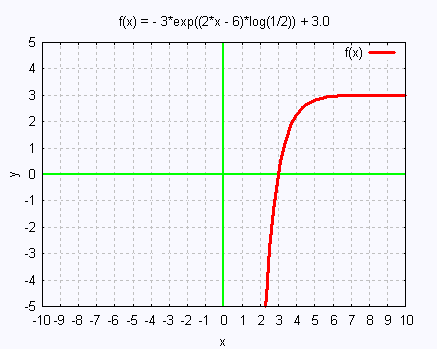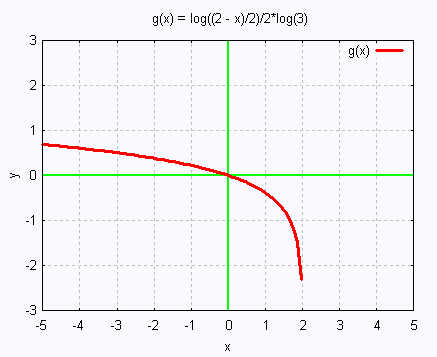Mathématiques 2: Fonctions exponetielles
1. f(x) = - 3.(1/2)2x -6 + 3
Dom = ℝ
f(x) = 0 si (1/2)2x -6 = 1
c'est à dire
ln((1/2)2x -6) = ln(1) = 0
(2 x - 6) ln(1/2) = 0 &rarr x = + 3
Asymptote y = 3
x→ 1000 y → 3
x→ - 1000 y → très grand négativement
Graphe

2. 45x -2 = 16
45x -2 = 16
(5x - 2) ln(4) = ln(16)
x = (ln(16)/ln(4) + 2)/5 = 4/5
3. 3- 2x + 3 - 2 = 4
3- 2x + 3 = 2
(- 2x + 3)ln(3) = ln(2)
- 2x + 3 = ln(2)/ln(3)
x = (3 - ln(2)/ln(3))/2
4. 3x2 + 4x + 4 = 2x + 1
(x2 + 4x + 4) ln(3) = (x + 1)ln(2)
x2 + 4x + 4 = (x + 1)ln(2)/ln(3)
x2 + (4 - ln(2)/ln(3))x + 4 - ln(2)/ln(3) = 0
Δ = (4 - ln(2)/ln(3))2 - 4 (1)(4 - ln(2)/ln(3)) =
(4 - ln(2)/ln(3))[(4 - ln(2)/ln(3)) - 4] =
- (4 - ln(2)/ln(3))(ln(2)/ln(3)
ln(2)/ln(3) = 0.69/1.1 = 0.63
Δ < 0 , donc pas de racines réelles.
S = Φ = {}
5. 72x - 3 - 33x + 2 =
27x - 1 + 49x
72x - 3 - 33x + 2 =
33(x - 1) + 72x
72x - 3 - 72x = 33x + 2 +
33(x - 1)
72x (7-3 - 1) = 33x(3+ 2 +
3- 3
72x /33x = (3+ 2 + 3- 3)/ (7-3 - 1)
(72/33)x = (3+ 2 + 3- 3)/ (7-3 - 1)
x = ln[(32 + 3-3)/(7-3 - 1)]/ln[(72/33)]
6. 35x = 4
35x = 4
5x ln(3) = ln(4)
5x = ln(4)/ln(3)
x = ln[ln(4)/ln(3)]/ln(5)
7. 2 + 53 x + 2 ≥ 7
2 + 53 x + 2 ≥ 7
53 x + 2 ≥ 5
53 x + 1 ≥ 1
(3 x + 1) ln(5)≥ ln(1) = 0
3 x + 1 ≥ 0
x ≥ - 1/3
8. (2/3)3 x - 4 ≤ - 3
Impossible puisqu'une exponetielle est toujours positive.
S = Φ = {}
9. f(x) = - 2.32x + 2
f(x) = - 2.32x + 2
y = - 2.32x + 2
(y - 2)/(-2) = 32x
2x ln(3) = ln[(2 - y)/2]
x = ln[(2 - y)/2]/2ln(3)
Réciproque de f(x) est g(x) telle que:
g(x) = ln[(2 - x)/2]/2ln(3)
Graphe:

10. Interêts composés
a)Interêts composés de Sylvain à 3.5% l'an
composé bi-annuellement = 2 fois l'an:
0 année: dépôt: Do = 4500$
1ers 6mois : dépôt devient: D1 =
4500$ + 4500$ x (3.5/2)% = 4500$ (1 + (3.5/2)%) = Do(1 + (3.5/2)%)
1ère année = 2 x 6 mois : dépôt devient: D2 = D1 + D1 x (3.5/2)% =
D1(1 + (3.5/2)%) = Do(1 + (3.5/2)%)2
5ère année : dépôt devient: D5 = Do(1 + (3.5/2)%)10
5 ans Sylvain possède D10 = Do (1 + (3.5/2))10 =
4500 (1 + (3.5/2)%)10 $ = 4500 x 1.19 = 5352.50 $
b) Interêts composés de Peter à 3.3% l'an:
0 jour: dépôt: Do = 4500$
1er jour: dépôt devient: D1 = 4500$ + 4500$ x (3.3/365)% =
= Do(1 + (3.3/365)%)
2eme jour: dépôt devient: D2 = D1 + D1x(3.3/365)% = D1(1 + (3.3/365)%) =
Do (1 + (3.3/365)%)2
3eme jour: dépôt devient: D3 = Do (1 + (3.3/365)%)3
5 ans = 5 x 365 jours = 1825 jours.
1825eme jour: dépôt devient: D1825 = Do (1 + (3.3/365)%)1825
5 ans Peter possède D1825 = Do (1 + (3.3/365)%)1825 =
D1825 = 4500 (1 + (3.3/365)%)1825 $ = 4500 x 1.179 = 5307.23 $
Il suffit de comparer les deux soldes:
Sylvain: DS = 5352.50 $ , et
Peter: DP = 5307.23 $
Une différence de 45.27 $ pour l'avantage de Sylvain.
|